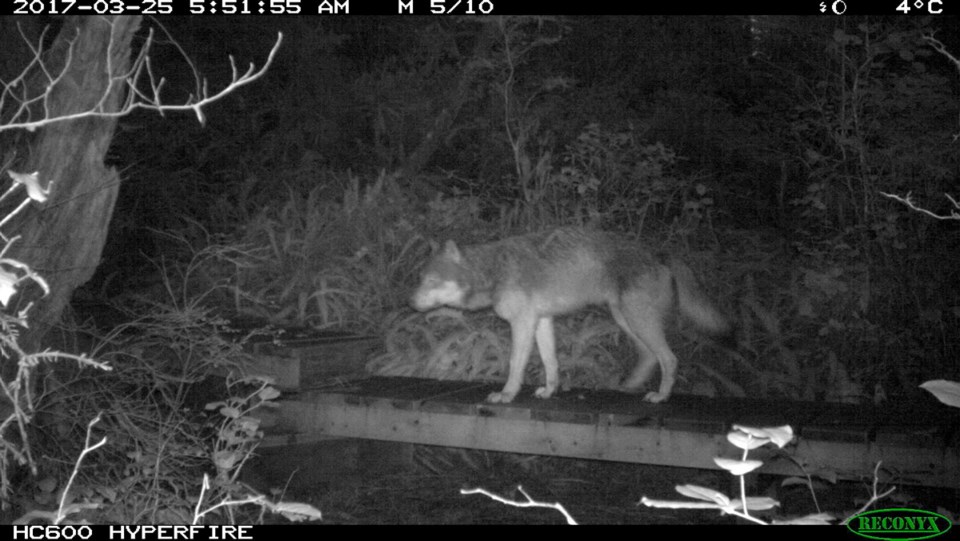The provincial government wants to extend the wolf-trapping season on Vancouver Island.
To which you reply: We trap wolves here?
Yes, we do, which some people think is terrible.
“Trapping is abhorrent,” says Trish Boyum.
The Royston woman and her husband own Ocean Adventures, which offers boat-based tours of the Great Bear Rainforest on the central mainland coast.
“The biggest draws for our clients are large carnivores,” she says. That means bears and wolves, the latter being the more elusive of the two.
Boyum spent 20 years in the trenches of the fight to end B.C.’s grizzly bear hunt, a struggle her side finally won last month. Her euphoria after that victory was dampened by the wolf-trapping news.
The government’s proposal is contained in the angling, hunting and trapping regulations that come up for renewal every two years. It recommends adding 51 days to Vancouver Island’s wolf-trapping season, which currently goes from Nov. 1 to June 30. The new start date would be Sept. 10.
The proposal says that while the province doesn’t have a firm handle on the wolf population on the north Island, anecdotal evidence indicates it is increasing. At the same time, deer numbers are dropping.
The Ministry of Forests, Lands, Natural Resource Operations and Rural Development also says wolf trapping is needed to protect Island elk, whose numbers are too low to allow hunting and are not increasing.
That said, there was no record of any wolves being trapped on Vancouver Island last year. The average for the past five years has been seven animals, the ministry said. It estimates the Island’s wolf population at 250 and rising. (That compares to the 250-to-400 estimate in a 1987 report.) Trapping will be done by First Nations or licensed commercial trappers, mostly on the north and central Island.
This all fits with a 2014 B.C. wolf-management plan that, while stating the government wasn’t sure how many of the animals are in the province (estimates ranged from 5,300 to 11,000), said there was no evidence of serious conservation concerns.
Among the plan’s goals was maintaining a self-sustaining population while also minimizing wolf attacks on livestock and “managing specific packs or individuals where predation is likely preventing the recovery of wildlife populations threatened by wolf predation.”
Here’s what else that 2014 report said: The whole wolf-control debate is “highly polarized.”
No kidding. Trapping proponents often characterize opponents as soft-handed city folk who get all worked up about back-country realities they don’t understand, allowing passion and populism to trump reason. (In announcing last March that the B.C. Liberals would outsource wildlife management to a new, arm’s-length group, then-Kootenay MLA Bill Bennett said: “Government is afraid to manage wolves, for example, or afraid to manage grizzly bears in some cases because of the politics of that.” Note that the Liberals’ idea disappeared after the NDP took power.)
Trapping opponents reply that bureaucrats, in trying to surgically slice away at one species to save others, risk meddling to the point that they cut off Mother Nature’s leg. Opponents don’t trust either the science or motivation behind wildlife-management decisions, arguing that hunting interests carry too much weight.
Boyum suspects the Island proposal has to do with leaving more deer for hunters in areas where both they and the wolves are after the same prey. “When wolves encroach on that, wolves pay the price.”
The grizzly bear campaign also left her dubious about the numbers government uses when estimating wildlife populations.
“The government doesn’t know,” she says. “They’re using various antiquated models to guesstimate.”
Having grown up on Interior cattle ranches, she is familiar with wolves being cast as villains, thinks it’s a rap they don’t deserve. So Ocean Adventures is bringing in wolf biologist Sadie Parr to speak at the Fallen Cedars Community Hall in Royston at 1 p.m. Jan 27. Groups like the Association for the Protection of Fur-Bearing Animals are wading into the issue, too.



